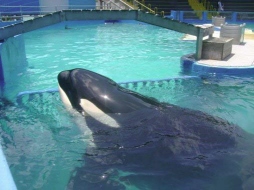Understanding how marine parks kill killer whales….
Posted January 28, 2011 at 4:21 am by Ian Byington
Susan Berta has been studying the negative effects of keeping killer whales in marine parks (by the way, there are no positive effects for the whales), and now shares this study that once again points out killer whale belong in the wild, not in amusement parks. Here’s more:
Former Trainers Show How Captivity Kills Orcas
A study titled “Keto & Tilikum Express the Stress of Orca Captivity” was released today after nearly a year in preparation showing how the conditions of captivity significantly decrease lifespan for orcas, and how captivity leads to aggression among captives and toward trainers. The paper was written by Drs Jeff Ventre and John Jett, who worked as trainers at Sea World of Florida for a combined total of 12 years with several orcas, including Tilikum, and with trainer Dawn Brancheau, who was tragically killed by Tilikum on Feb. 24, 2010.
This is a major breakthrough and a landmark achievement in the history of orca captivity.
View the paper at:
http://theorcaproject.wordpress.com/
In this paper you’ll see the precursors and symptoms of stresses in orcas in captivity, illustrated with powerful photos. As former trainers at SeaWorld Orlando, and now a medical doctor and biology professor respectively, they have a perspective that has not been heard in the intensifying debate about captivity for orcas. Having been deeply enmeshed in those arguments for over 15 years, we can attest that seldom, if ever, has anyone discussed many of the topics covered here. Some of the major themes include shortened longevity, breeding of young mothers, severe tooth damage found in many captives and associated systemic illnesses, inbreeding, and the social tensions that often erupt in hostile behavior or violence toward other whales or trainers.
Ventre and Jett provide detailed observations and strong statistical calculations that add up to an abundance of evidence that captivity kills orcas, usually at a young age, and that stresses, social tensions and poor health are chronic issues in marine park facilities. A new statistic is compiled called “Mean Duration of Captivity” (MDC), drawn from diverse credible sources, that allow overall comparisons with free-ranging orcas, revealing shockingly low average longevity in captivity.
We often hear about how orcas suffer in captivity, but sometimes it’s hard to understand what that means. In this article the reader can see the burnt backs and eye cataracts from floating listlessly on the surface looking up at trainers. With reference to what is known about the expansive travels, family bonds and cultural lives of free-ranging orcas, we can empathize with the traumas of capture, separation and shipment, the attempts to construct ad hoc social relationships and hierarchies in contrived groupings that are manipulated for management purposes. The dismal captive mortality rates revealed here make sense when these stressors are understood.
Everyone will learn something from this paper.
This is a comprehensive treatment of orca captivity, starting from the context of the conditions of captivity and how that relates to the two trainer deaths in the past year, and arriving at suggested mitigations and how to best phase out the practice. The point of view of the whales themselves is a key element here that is seldom, if ever, seen in the controversies over orca captivity. Ventre and Jett have kept their focus on the evidence, on what’s happening to the orcas, how the conditions and symptoms add up to express the stresses of captivity. When this study goes out across the media I’m quite sure we will soon see a new public conversation about the effects of captivity on the orcas themselves.
“Keto & Tilikum Express the Stress of Orca Captivity” is available for public distribution at The Orca Project at:
http://theorcaproject.wordpress.com/
You can support the San Juan Update by doing business with our loyal advertisers, and by making a one-time contribution or a recurring donation.
Categories: Enviro Corner











No comments yet. Be the first!
By submitting a comment you grant the San Juan Update a perpetual license to reproduce your words and name/web site in attribution. Inappropriate, irrelevant and contentious comments may not be published at an admin's discretion. Your email is used for verification purposes only, it will never be shared.